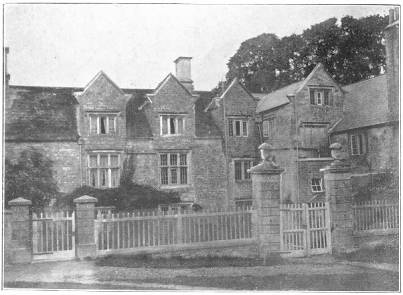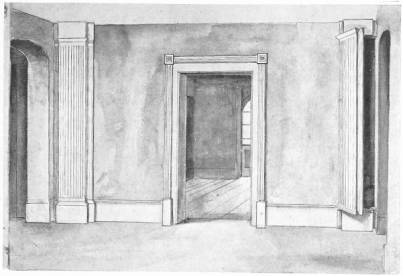Secret Chambers and Hiding Places, by Allan Fea
CHAPTER XV
HIDING-PLACES OF SMUGGLERS AND THIEVES
Horsfield, in his History of Sussex, gives a curious account of the discovery in 1738 of an iron chest in a recess of a wall at the now magnificent ruin Hurstmonceaux Castle. In the thickness of the walls were many curious staircases communicating with the galleries. When the old castle was allowed to fall into ruin, the secret passages, etc., were used by smugglers as a convenient receptacle for contraband goods.
Until recently there was an ingenious hiding-place behind a sliding panel at the old "Bell Inn" at Sandwich which had the reputation of having formerly been put to the same use; indeed, in many another old house near the coast were hiding-places utilised for a like purpose.
In pulling down an old house at Erith in 1882 a vault was discovered with strong evidence that it had been extensively used for smuggling. The pretty village of Branscombe, on the Devonshire coast, was, like the adjacent village of Beer, a notorious place for smugglers. "The Clergy House," a picturesque, low-built Tudor building (condemned as being insecure and pulled down a few years ago), had many mysterious stories told of its former occupants, its underground chambers and hiding-places; indeed, the villagers went so far as to declare that there was another house beneath the foundations!
A secret chamber was discovered at the back of a fireplace in an old house at Deal, from which a long underground passage extended to the beach. The house was used as a school, and the unearthly noises caused by the wind blowing up this smugglers' passage created much consternation among the young lady pupils. A lady of our acquaintance remembers, when a schoolgirl at Rochester, exploring part of a vaulted tunnel running in the direction of the castle from Eastgate House, which in those days was a school, and had not yet received the distinction of being the "Nun's House" of Edwin Drood. Some way along, the passage was blocked by the skeleton of a donkey! Our informant is not given to romancing, therefore we must accept the story in good faith.
All round the coast-line of Kent once famous smuggling buildings are still pointed out. Movable hollow beams have been found supporting cottage ceilings, containing all kinds of contraband goods. In one case, so goes the story, a customs house officer in walking through a room knocked his head, and the tell-tale hollow sound (from the beam, not from his head, we will presume) brought a discovery. At Folkestone, tradition says, a long row of houses used for the purpose had the cellars connected one with the other right the way along, so that the revenue officers could be easily evaded in the case of pursuit.
The modern utility of a convenient secret panel or trap-door occasionally is apparent from the police-court reports. The tenements in noted thieves' quarters are often found to have intercommunication; a masked door will lead from one house to the other, and trap-doors will enable a thief to vanish from the most keen-sighted detective, and nimbly thread his way over the roofs of the neighbouring houses. There was a case in the papers not long since; a man, being closely chased, was on the point of being seized, when, to the astonishment of his pursuers, he suddenly disappeared at a spot where apparently he had been closely hemmed in.
Many old houses in Clerkenwell were, sixty or seventy years ago, notorious thieves' dens, and were noted for their hiding-places, trap-doors, etc., for evading the vigilance of the law. The name of Jack Sheppard, as may be supposed, had connection with the majority. One of these old buildings had been used in former years as a secret Jesuits' college, and the walls were threaded with masked passages and places of concealment; and when the old "Red Lion Inn" in West Street was pulled down in 1836, some artful traps and false floors were discovered which tarried well with its reputation as a place of rendezvous and safety for outlaws. The "Rising Sun" in Holywell Street is a curious example, there being many false doors and traps in various parts of the house; also in the before-mentioned Newton Street a panel could be raised by a pulley, through which a fugitive or outlaw could effect his escape on to the roof, and thence into the adjoining house.
One of the simplest and most secure hiding-places perhaps ever devised by a law-breaker was that within a water-butt! A cone-shaped repository, entered from the bottom, would allow a man to sit within it; nevertheless, to all intents and purposes the butt was kept full of water, and could be apparently emptied from a tap at its base, which, of course, was raised from the ground to admit the fugitive. We understand such a butt is still in existence somewhere in Yorkshire.
A "secret staircase" in Partingdale House, Mill Hill, is associated (by tradition) with the notorious Dick Turpin, perhaps because of its proximity to his haunts upon Finchley Common. As it exists now, however, there is no object for secrecy, the staircase leading merely to the attics, and its position can be seen; but the door is well disguised in a Corinthian column containing a secret spring. Various alterations have taken place in this house, so once upon a time it may have had a deeper meaning than is now perceptible.
Another supposed resort of this famous highwayman is an old ivy-grown cottage at Thornton Heath. Narrow steps lead up from the open chimney towards a concealed door, from which again steps descend and lead to a subterranean passage having an exit in the garden.

BOVEY HOUSE, SOUTH DEVON

MAPLEDURHAM HOUSE, OXFORDSHIRE
We do not intend to go into the matter of modern secret chambers, and there are such things, as some of our present architects and builders could tell us, for it is no uncommon thing to design hiding-places for the security of valuables. For instance, we know of a certain suburban residence, built not more than thirty years ago, where one of the rooms has capacities for swallowing up a man six feet high and broad in proportion. We have known such a person—or shall we say victim?—to appear after a temporary absence, of say, five minutes, with visible signs of discomfort; but as far as we are aware the secret is as safe in his keeping as is the famous mystery in the possession of the heir of Glamis.
An example of a sliding panel in an old house in Essex (near Braintree) was used as a pattern for the entrance to a modern secret chamber;[1] and no doubt there are many similar instances where the ingenuity of our ancestors has thus been put to use for present-day requirements.
[Footnote 1: According to the newspaper reports, the recently recovered "Duchess of Devonshire," by Gainsborough, was for some time secreted behind a secret panel in a sumptuous steam-launch up the river Thames, from whence it was removed to America in a trunk with a false bottom.]
Our collection of houses with hiding-holes is now coming to an end. We will briefly summarise those that remain unrecorded.
"New Building" at Thirsk has, or had, a secret chamber measuring three feet by six. Upon the outside wall on the east side of the house is a small aperture into which a stone fitted with such nicety that no sign of its being movable could possibly be detected; at the same time, it could be removed with the greatest ease in the event of its being necessary to supply a person in hiding with food.
Catledge Hall, Cambridgeshire, has a small octangular closet adjoining a bedroom, from which formerly there was a secret way on to the leads of the roof.

MAPLEDURHAM HOUSE, OXFORDSHIRE

ENTRANCE TO SECRET STAIRCASE, PARTINGDALE HOUSE, MILL-HILL, MIDDLESEX
At Dunkirk Hall, near West Bromwich, is a "priest's hole" in the upper part of the house near "the chapel," which is now divided into separate rooms.
Mapledurham House, axon, the old seat of the Blounts, contains a "priest's hole" in the attics, descent into which could be made by the aid of a rope suspended for that purpose.
Upton Court, near Slough, possesses a "priest's hole," entered from a fireplace, provided with a double flue—one for smoke, the other for ventilation to the hiding-place.
Knebworth House, Hertfordshire, formerly had a secret chamber known as "Hell Hole."
Eastgate House, Rochester (before mentioned), has a hiding-place in one of the upstairs rooms. It has, however, been altered.
Milsted Manor, Kent, is said to have a secret exit from the library; and Sharsted Court (some three miles distant) has a cleverly marked panel in the wainscoting of "the Tapestry Dressing-room," which communicates by a very narrow and steep flight of steps in the thickness of the wall with "the Red Bedroom."
The "Clough Inn," Chard, Somersetshire, is said by tradition to have possessed three secret rooms!
Cawdor Castle, Nairnshire—a hiding-place formerly in "the tower." Bramhall Hall, Cheshire—two secret recesses were discovered not long ago during alterations. The following also contain hiding-places:—Hall-i'-the-wood, Bolling Hall, Mains Hall, and Huncoat Hall, all in Lancashire; Drayton House, Northants; Packington Old Hall, Warwickshire; Batsden Court, Salop; Melford Hall, Suffolk, Fyfield House, Wilts; "New Building," Southwater, Sussex; Barsham Rectory, Suffolk; Porter's Hall, Southend, Essex; Kirkby Knowle Castle and Barnborough Hall, Yorkshire; Ford House, Devon; Cothele, Cornwall; Hollingbourne Manor House, Kent (altered of late years); Salisbury Court, near Shenley, Herts.
Of hiding-places and secret chambers in the ancient castles and mansions upon the Continent we know but little.
Two are said to exist in an old house in the Hradschin in Prague—one communicating from the foundation to the roof "by a windlass or turnpike." A subterranean passage extends also from the house beneath the street and the cathedral, and is said to have its exit in the Hirch Graben, or vast natural moat which bounds the château upon the north.
A lady of our acquaintance remembers her feeling of awe when, as a school-girl, she was shown a hiding-place in an old mansion near Baden-Baden—a huge piece of stone masonry swinging aside upon a pivot and revealing a gloomy kind of dungeon behind.
The old French châteaux, according to Froisart, were rarely without secret means of escape. King Louis XVI., famous for his mechanical skill, manufactured a hiding-place in an inner corridor of his private apartments at the Palace of Versailles. The wall where it was situated was painted to imitate large stones, and the grooves of the opening were cleverly concealed in the shaded representations of the divisions. In this a vast collection of State papers was preserved prior to the Revolution.[1]
[Footnote 1: Vide The Memoirs of Madame Campan.]
Mr. Lang tells us, in his admirable work Pickle the Spy, that Bonnie Prince Charlie, between the years 1749 and 1752, spent much of his time in the convent of St. Joseph in the Rue St. Dominique, in the Faubourg St. Germain, which under the late Empire (1863) was the hotel of the Minister of War. Here he appears to have been continually lurking behind the walls, and at night by a secret staircase visiting his protectress Madame de Vassés. Allusion is made in the same work to a secret cellar with a "dark stair" leading to James III.'s furtive audience-chamber at his residence in Rome.
So recently as the year 1832 a hiding-place in an old French house was put to practical use by the Duchesse de Berry after the failure of her enterprise to raise the populace in favour of her son the Duc de Bordeaux. She had, however, to reveal herself in preference to suffocation, a fire, either intentionally or accidentally, having been ignited close to where she was hidden, recalling the terrible experiences of Father Gerard at "Braddocks."
Index | Next: The Scottish Hiding-Places Of Princes Charles Edward
